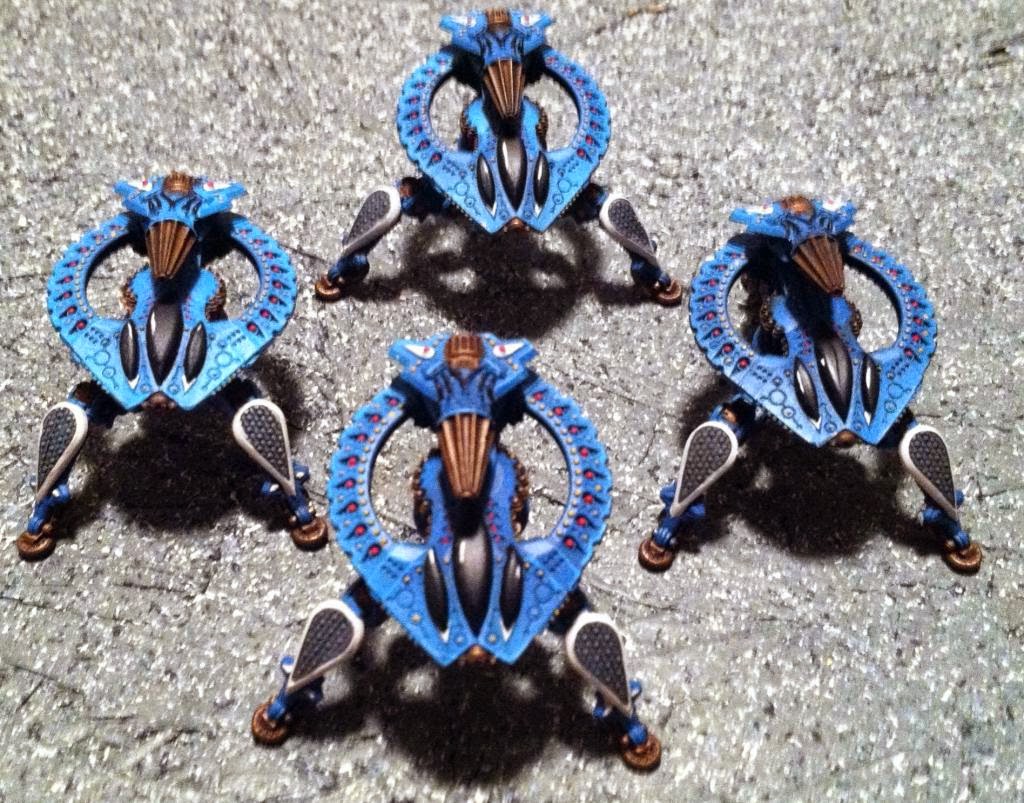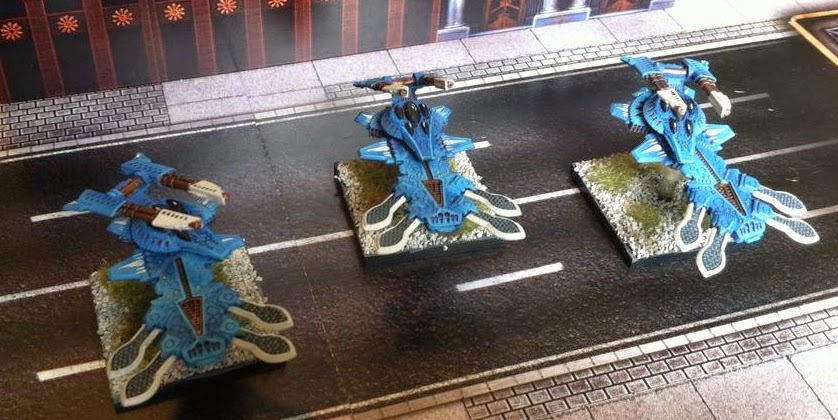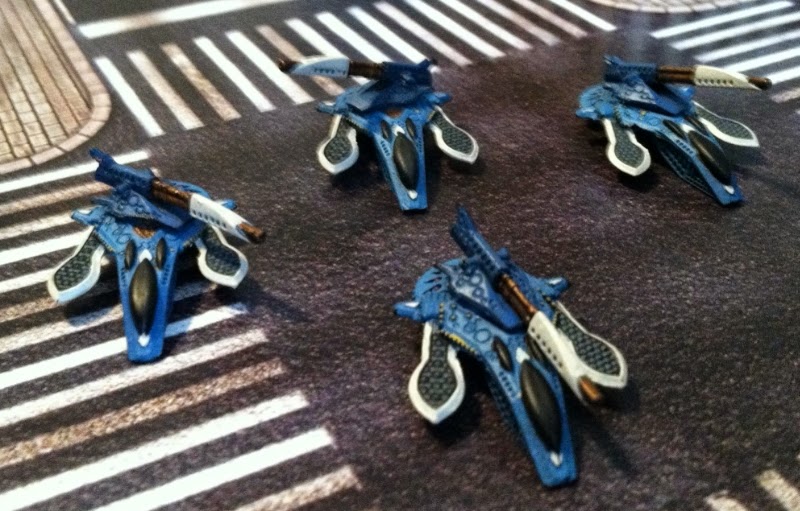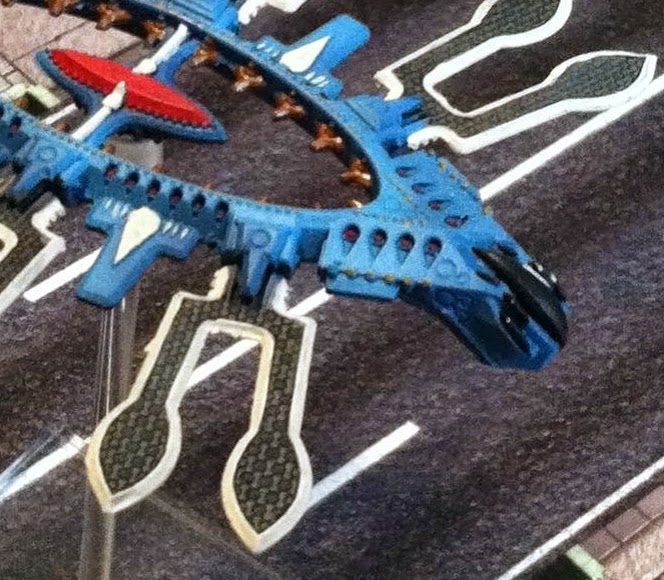Dropzone Tactics: Meet the Shaltari Tribes
7 Minute Read
Jan 8 2015

Advertisement
A happy new year to you all, Dropzone fans! Today we kick off our first faction-specific tactics article, with the sneaky Shaltari Tribes!
I still remember the exact moment when I decided I wanted to play Shaltari Tribes. I read through the rules system for Shaltari Gates, and stopped myself, scratching my head and saying, “Huh?” I went back and reread the rules, then did so a third time. At this point, I thought I had a good grasp on how their teleportation systems worked. I then noticed that most of their units have weak armor, low Energy weapons, and cost a significant amount compared to their opponents. It was then that I realized the Shaltari had that indefinable trait, the one that simply cannot be measured until you reach the tabletop.
Trickery…
In every other game system, I always play the straightforward army or class. In the Diablo games, I was always a Barbarian. In 40k, I always played the melee oriented forces, or those with an overwhelming amount of firepower. I decided then and there that Dropzone would be different. My first army would be a true test of generalship. With no clear advantage on paper against my foes, I bravely teleported onto the battlefield against the United Colonies of Man.
Over the coming weeks, I’ll be sharing my insights into this enigmatic faction, hopefully girding you against some of those early mistakes I made. From straight-on gun battles between my poor Tomahawks and the UCM’s Sabres, to too few Gates to maneuver my troops after casualties had taken their toll, I will do my best to share what I have learned and where it has left me as a player.
Sun Tzu said:
“All warfare is based on deception. Hence, when able to attack, we must seem unable; when using our forces, we must seem inactive; when we are near, we must make the enemy believe we are far away; when far away, we must make him believe we are near.”
In a very real sense, the Shaltari Tribes embody this quote. While they lack the strength to fight most foes on an equal footing, they should never have to engage in such a battle. This brings me to my first point in this Tactics series: The Shaltari are built around deception.Your goal at any given moment is to keep the enemy confused as to where the main strike will land. The three primary ways to bring this plan to fruition are Speed, Diversionary Units, and Gate Technology.
Speed
Speed is one of the biggest advantages to harness as a Shaltari general. Shaltari Walkers are at least as fast as similar units in enemy armies, and their tanks match or exceed the pace set by everyone else (except the Scourge). In the instance of the Scourge, superior range allows this slight disadvantage in speed to be mitigated.
Speed has several important factors when contributing to deception. It is quite easy to reposition for attack against a different vector, meaning the enemy should only ever have one turn to predict and reposition for your incoming attack. In addition, this speed allows the Shaltari to break off their attack when it is no longer tenable to press the advantage. This is augmented by the above average speed of Shaltari Gates (discussed more later), allowing the movement of Aircraft and Ground units to rapidly change the dictation of an enemy’s defense. This also gives Shaltari ready access to seize the initiative, even when it has been lost on a former front.
The ability to outpace a foe also contributes to effectiveness when dealing offensive damage. Scourge battle tanks will take a serious tally in Shaltari equivalents, but it will take them several turns to reach optimum range. As a very abstract example, consider that a Tomahawk can engage a Hunter from 24” away. The Hunter must close to 12” to engage, meaning it will have to cover 12” of danger zone before it can engage. While it can move 9” each turn to bring this distance to a close, a Tomahawk has a MF of 6”, meaning the Scourge tank can only effectively close 3” per turn, giving the Tomahawk two shots before the Hunter comes into range. Admittedly this is a very abstract concept, but it is a sound one. This significant speed can also be used to disengage from foes that would win a protracted battle against Shaltari skimmers, such as blocks of Sabres and PHR Odins.
It is also important to remember that a Shaltari Skimmer CAN move at the same speed as its Scourge counterpart, it simply cannot fire when doing so. A full move away can pull the Hunter formation out of position against better targets, and if they refuse to take the bait then any turns spent chasing the Tomahawks have been wasted.
Diversionary Units
The last point above segues nicely into Diversionary Units, and how they can be used to reinforce Shaltari deception.
The simple fact of the matter is that Shaltari units are frequently outclassed by points-similar equivalents. This isn’t always the case, but it frequently seems to be true. In order to overcome this shortfall, Shaltari generals must take advantage of mental perceptions from the opponent.
Enter the humble Yari.
For example, a small squad of Yaris is enough to threaten CQB specialists, along with any other units in light dropships. The opponent must make a decision with these Yaris; he can either leave them to do their damage, deploy to combat them, or redirect his energies around them. With the proper Gates in place (again, more on them next), the Shaltari have the capacity to use this small Scout unit in several ways. First, it can simply remain a diversion, pulling your opponent into an engagement that never escalates, or securing a zone on the table for next to no points cost. It can also be used as the bait for an escalating engagement, in which the Shaltari dump more and more reinforcements into a fight that slowly turns against an enemy element. Finally, it can simply be a drain on the opponent’s resources, pulling them closer and closer to a unit they cannot yet see until, at the last moment, the Yaris utilize Gates to exit the area.
In any situation, this can be turned into a win for the Shaltari force. The trick is learning how to spread the diversionary units around the table, giving your opponent the illusion that you’re overextended or without support.
Gate Technology
Gates are the greatest asset a Shaltari commander can use, yet time and again I find myself (and other Shaltari players online) leaving them at home in favor of more offensive units. While it is important to strike a balance on your Gate Pool to maximize force efficiency, it is also important to bring enough Gates to weather some attrition and still complete the required missions. Without Gates, the Shaltari are really nothing special!
The greatest contribution from Gates comes in the fact that they can be “shared” between force elements. The other factions must use one dedicated dropship for each unit, whereas the Shaltari can do as they please each turn. This opens us up for a great amount of tactical flexibility, but it also requires a greater mastery of the army’s mechanics.
As an example of this, consider the following. A Shaltari force includes two units of four Yaris with Ion Cannons, along with four Spirit Light Gates. These Gates can push the Yaris to cover at the center of the table on Turn One, presenting the enemy with a difficult maneuver problem in order to get their specialists forward. Even if they make it to the Structures across the center of the table, they still run the risk of the Yaris downing their transport, leaving them with no way to evacuate an objective. From this point the Yaris are in position to complete their mission, but the Spirits are still fulfilling the roles of diversion and deception.
Your opponent must now guess at your intent. These Spirit Gates can bring a plethora of Infantry down on any Structure they choose to assail across the center, making an early jump for these objectives potentially suicidal. Without splitting his AA assets to blanket the entire board, he will also be forced into a position where his own Deployment Zone becomes untenable. To make the situation even more maddening, he will be forced to consider the dangers of more units being teleported into his flanks if he spreads his army out.
It would be insulting to say that the enemy could not counter all of these problems efficiently. However, the point I’m trying to make is that you can cause continual confusion and thought conflict by spreading the board early and testing your opponent’s defenses. The Gates give the Shaltari easy capacity to commit later and more efficiently than their opponent. This translates to battlefield initiative, which is of inestimable worth.
For those Shaltari players in the audience: What have you found to be the biggest strengths of this army? Did the army play as you expected, or much differently? What was your “Aha!” moment in deciding to play Shaltari?
For a healthy dose of gaming insanity, visit us at Enter the Maelstrom.
Author: Randall Madden
Advertisement





